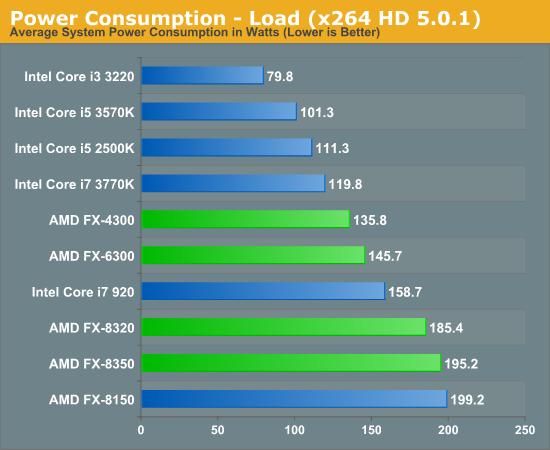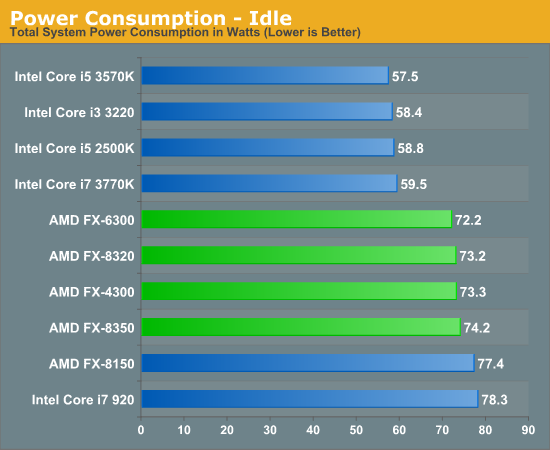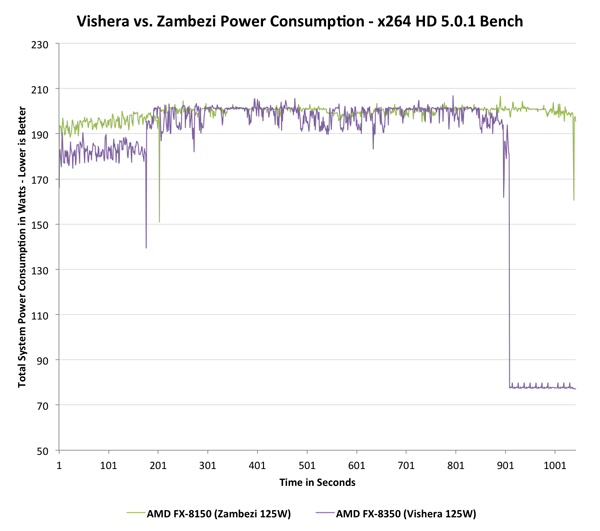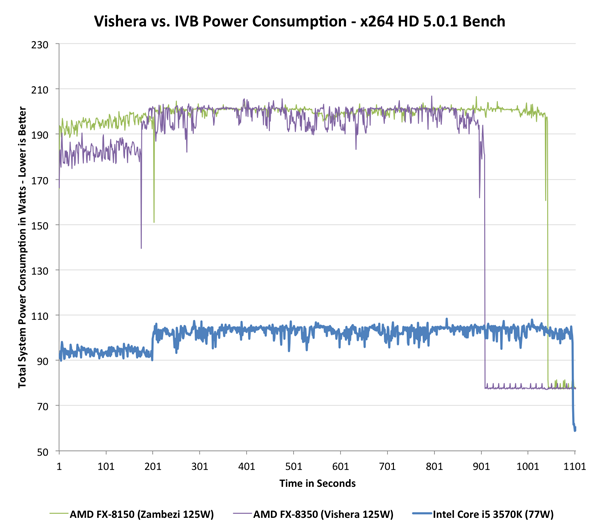The Vishera Review: AMD FX-8350, FX-8320, FX-6300 and FX-4300 Tested
by Anand Lal Shimpi on October 23, 2012 12:00 AM ESTPower Consumption
With Vishera, AMD was in a difficult position: it had to drive performance up without blowing through its 125W TDP. As the Piledriver cores were designed to do just that, Vishera benefitted. Remember that Piledriver was predominantly built to take this new architecture into mobile. I went through the details of what makes Piledriver different from its predecessor (Bulldozer) but at as far as power consumption is concerned, AMD moved to a different type of flip-flop in Piledriver that increased complexity on the design/timing end but decreased active power considerably. Basically, it made more work for AMD but resulted in a more power efficient chip without moving to a dramatically different architecture or new process node.
In mobile, AMD used these power saving gains to put Piledriver in mobile APUs, a place where Bulldozer never went. We saw this with Trinity, and surprisingly enough it managed to outperform the previous Llano generation APUs while improving battery life. On desktops however, AMD used the power savings offered by Piledriver to drive clock speeds up, thus increasing performance, without increasing power consumption. Since peak power didn't go up, overall power efficiency actually improves with Vishera over Zambezi. The chart below illustrates total system power consumption while running both passes of the x264 HD (5.0.1) benchmark to illustrate my point:
In the first pass Vishera actually draws a little less power, but once we get to the heavier second encode pass the two curves are mostly indistinguishable (Vishera still drops below Zambezi regularly). Vishera uses its extra frequency and IPC tweaks to complete the task sooner, and drive down to idle power levels, thus saving energy overall. The picture doesn't look as good though if we toss Ivy Bridge into the mix. Intel's 77W Core i5 3570K is targeted by AMD as the FX-8350's natural competitor. The 8350 is priced lower and actually outperforms the 3570K in this test, but it draws significantly more power:
The platforms aren't entirely comparable, but Intel maintains a huge power advantage over AMD. With the move to 22nm, Intel dropped power consumption over an already more power efficient Sandy Bridge CPU at 32nm. While Intel drove power consumption lower, AMD kept it constant and drove performance higher. Even if we look at the FX-8320 and toss Sandy Bridge into the mix, the situation doesn't change dramatically:
Sandy Bridge obviously consumes more than Ivy Bridge, but the gap between a Vishera and any of the two Intel platforms is significant. As I mentioned earlier however, this particular test runs quicker on Vishera however the test would have to be much longer in order to really give AMD the overall efficiency advantage.
If we look at average power over the course of the two x264 encode passes, the results back up what we've seen above:

As more client PCs move towards smaller form factors, power consumption may become just as important as the single threaded performance gap. For those building in large cases this shouldn't be a problem, but for small form factor systems you'll want to go Ivy Bridge.
Note that idle power consumption can be competitive, but will obviously vary depending on the motherboard used (the Crosshair Formula V is hardly the lowest power AM3+ board available):














250 Comments
View All Comments
klatscho - Tuesday, October 23, 2012 - link
but at least priced decently.leexgx - Tuesday, October 23, 2012 - link
still like how AMD think they have 8 full cores in there (some sites list the Modules not FP cores in their lists)8x is 4 Modules (4M/8T)
6x is 3 Modules (3M/6T)
4x is 2 Modules (2M/4T)
they hardly outperform stock clocked matched cpus (that they listed)
leexgx - Tuesday, October 23, 2012 - link
also to add if you own an Bulldozer (or Vishera) type of cpu you should all ready have these patches installedhttp://support.microsoft.com/kb/2646060
http://support.microsoft.com/kb/2645594
Penti - Wednesday, October 24, 2012 - link
There are 8 fully pipelined integer cores in there, they are just very weak. Some of it is the shared frontend/decoder some of it is the integer execution units themselves. Weak SIMD/FPU-performance isn't the only thing it got. It just does so much less. You don't have two pipelines with separate resources to achieve SMT/HT. They need wider execution here. Preferably dropping the shared front end thing too. Makes no point of having it around, focus on making it faster and dump all that cache which does no good. Mobile/Notebook chips can't really have 16MB of cache any way. Just a few MB.DDR4 - Wednesday, November 7, 2012 - link
It's just a marketing thing, the cores don't have that much power, AMD's just looking to do better than Intel in one area.P39Airacobra - Wednesday, May 14, 2014 - link
And you base this on the first that came to your mind to make you feel better about you over paying for your wimpy little 4 core Intel CPU with half the power of a FX-8320. LOLP39Airacobra - Wednesday, May 14, 2014 - link
Just kidding I have a i5 myself, But guys you really should stop being such fanboys. AMD has a great Chip here with the FX-8320 and FX-8350. They are priced much lower than the top i5 CPU, And they will perform just as well in gaming if not better. And who cares about it using 125 watts? 125 watts is a bit more than what Intel's i5's use , But it can still be ran more than fine with a High end GPU with just a decent 600watt mainstream PSU like a CX600.spooky2th - Tuesday, June 3, 2014 - link
Intel i5's can handle faster memory than any amp chip. They have a stronger MC plus they OC very well too. With the 1155 socket the amd chips were barely keeping up. Since haswell the speed champs are intel cpu's hands down and with the z97 boards and the new processors that will only work with the 97 boards, look out amd! Better OC'ing and handling faster memory than before!DesiredUser - Friday, February 12, 2016 - link
Currently, FX-8350 costs over $200.Used Xeon 5647 costs just $50 and beats a crap out of it.
Both support ECC. Go figure.
Homeles - Sunday, October 28, 2012 - link
Because performance = core count. Brilliant.